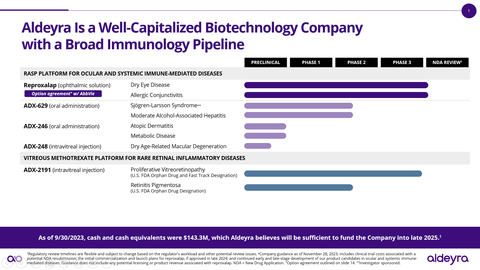- Based on positive biomarker results observed in adult cohort of Phase 2 clinical trial of ADX-629 in Sjögren-Larsson Syndrome, proposed expansion to include pediatric patients expected to be submitted to the US Food and Drug Administration (FDA) in the first half of 2024
- Phase 2 clinical trial of ADX-629 in moderate alcoholic hepatitis initiated; top-line results expected in the second half of 2024
- Investigational New Drug (IND) application of ADX-246 submitted to FDA for Phase 1 clinical trial in healthy volunteers expected to be expanded to include patients with atopic dermatitis
- IND application of ADX-248 expected to be submitted to FDA for Phase 1/2 clinical trial in dry age-related macular degeneration patients with dark adaptation deficit in 2024
- Special Protocol Assessment for clinical trial of reproxalap in dry eye disease amended based on FDA feedback
Aldeyra Therapeutics, Inc. (Nasdaq: ALDX) (Aldeyra), a biotechnology company devoted to discovering and developing innovative therapies designed to treat immune-mediated diseases, today announced advancement of its RASP modulator platform, including the expected submission to the FDA of a proposed expansion of the Phase 2 clinical trial of the investigational RASP modulator ADX-629 in Sjögren-Larsson Syndrome to include pediatric patients, initiation of a Phase 2 clinical trial of ADX-629 in moderate alcoholic hepatitis, submission of an IND application of the investigational RASP modulator ADX-246 for a Phase 1 clinical trial that is expected to be expanded to include atopic dermatitis patients, anticipated submission of an IND application of the investigational RASP modulator ADX-248 for a Phase 1/2 clinical trial in patients with the dry form of age-related macular degeneration (AMD) and dark adaptation deficit, and initiation of a preclinical program of RASP modulators in metabolic disease.
This press release features multimedia. View the full release here: https://www.businesswire.com/news/home/20240104883191/en/

(Graphic: Aldeyra Therapeutics)
“With an unparalleled RASP modulator discovery and development platform, Aldeyra remains a leader in the development of RASP modulators for the treatment of immune-mediated disease,” stated Todd C. Brady, M.D., Ph.D., President and Chief Executive Officer of Aldeyra.
Sjögren-Larsson Syndrome is a rare inborn error of metabolism due to mutations in fatty aldehyde dehydrogenase, leading to accumulation of fatty alcohols and fatty aldehydes. The disease is characterized clinically by cognitive delay, spasticity, and dermal compromise. There is no FDA-approved therapy for Sjögren-Larsson Syndrome. ADX-629, administered twice daily over 90 days, has completed initial clinical testing in three adult patients in an investigator-sponsored clinical trial. Broad-based normalization of the majority of abnormal metabolomic signatures was observed along with reduction in accumulation of fatty alcohols. A proposed expansion of the clinical trial to include pediatric patients is expected to be submitted to the FDA in the first half of 2024.
Moderate alcoholic hepatitis is a common disease that leads to significant morbidity and mortality due to hepatic compromise and related complications. There is no FDA-approved therapy for alcoholic hepatitis. In preclinical models of ethanol toxicity, ADX-629 decreased hepatic levels of RASP, triglycerides, and inflammatory cytokines. In a sequence-randomized, double-masked, placebo-controlled crossover Phase 2 clinical trial announced last year, relative to placebo, ADX-629 reduced dermal flushing (P=0.0007), increased Romberg test balance time (P=0.02), and lowered levels of the ethanol RASP metabolite acetaldehyde (P=0.03) following acute exposure to alcohol. The moderate alcoholic hepatitis Phase 2 clinical trial is intended to assess the activity of ADX-629, administered orally twice daily over 90 days, initially in approximately 10 patients. The primary endpoint is safety and tolerability; secondary endpoints include liver function biomarkers, model for end-stage liver disease (MELD) score, hospitalization, and mortality rate. Top-line results from the first patient cohort are expected in the second half of 2024.
Atopic dermatitis is a common disease characterized by immune dysregulation that leads to hyperreactivity to endogenous and exogenous factors, potentially including RASP. There is no widely accepted oral therapy for the treatment of patients with mild to moderate atopic dermatitis. Recently announced results from a 90-day, open-label Phase 2 clinical trial of orally administered ADX-629 in eight mild to moderate atopic dermatitis patients demonstrated statistically significant and clinically relevant improvement in investigator-assessed and patient-reported outcomes across a number of different physiological and psychosocial assessments, including complete resolution of affected body surface area observed in one patient and elimination of itching reported by two patients. Based on the results of the clinical trial, an IND application of next-generation investigational RASP modulator ADX-246 for a Phase 1 clinical trial in healthy volunteers has been submitted to the FDA and is expected to be expanded to include clinical testing in patients with atopic dermatitis. The clinical trial is anticipated to be initiated in the first half of 2024, and top-line results are expected in the second half of 2024.
AMD is a common disease, the so-called dry form of which is characterized by accumulation of toxic metabolites in the retina and visual deficit, typically beginning with difficulty seeing in low-light settings. Metabolites of RASP are associated with compromise in dark adaptation. Based on data demonstrating that RASP modulation reduces accumulation of toxic metabolites in a preclinical model of AMD, an IND application of next-generation investigational RASP modulator ADX-248 is expected to be submitted in 2024. The Phase 1/2 clinical trial is anticipated to enroll dry AMD patients with dark adaptation deficit.
Highlighting the advancement of the RASP platform and the selection of key clinical indications for future development, Aldeyra released a focused pipeline. The previously announced programs of ADX-629 in chronic cough and idiopathic nephrotic syndrome have been de-prioritized due to regulatory and trial feasibility challenges, respectively. In addition, a new preclinical RASP modulator program in metabolic disease has been announced, supported by a number of clinical trials with ADX-629 that demonstrated a reduction in triglycerides and cholesterol.
Based on Special Protocol Assessment feedback received from the FDA last week on reproxalap in dry eye disease, Aldeyra has amended the proposed clinical trial protocol and statistical analysis plan.
“With the success achieved in our ADX-629 program, which includes a number of positive, signal-finding clinical results, we are excited to advance our RASP modulator pipeline to systemic and retinal immune-mediated diseases, as well as metabolic diseases, exacerbated by RASP,” stated Dr. Brady. “We anticipate 2024 to provide a variety of clinical-stage catalysts, as Aldeyra continues to progress its novel RASP platform.”
About Aldeyra
Aldeyra Therapeutics is a biotechnology company devoted to discovering innovative therapies designed to treat immune-mediated diseases. Our approach is to develop pharmaceuticals that modulate immunological systems, instead of directly inhibiting or activating single protein targets, with the goal of optimizing multiple pathways at once while minimizing toxicity. Our product candidates include RASP (reactive aldehyde species) modulators ADX‑629, ADX‑246, ADX‑248, and chemically related molecules for the potential treatment of systemic and retinal immune-mediated diseases. Our pre-commercial product candidates are reproxalap, a RASP modulator for the potential treatment of dry eye disease and allergic conjunctivitis, and ADX-2191, a novel formulation of intravitreal methotrexate for the potential treatment of proliferative vitreoretinopathy and retinitis pigmentosa.
About RASP Modulators ADX-629, ADX-246, and ADX-248
ADX-629 is an orally administered RASP modulator currently in development as a signal-finding molecule for the treatment of mass-market immune-mediated diseases. ADX-629 has demonstrated potential activity in clinical trials of patients with psoriasis, asthma, COVID, ethanol toxicity, chronic cough, and atopic dermatitis. In more than 100 healthy volunteers and patients, no consistent adverse events associated with ADX-629 have been identified.
An analog of ADX-629, ADX-246 is an orally administered next-generation RASP modulator expected to initiate clinical testing in the first half of 2024 in a Phase 1/2 clinical trial in healthy volunteers and patients with atopic dermatitis. Top-line results from the Phase 1/2 clinical trial are expected in the second half of 2024.
ADX-248 is an intravitreally administered RASP modulator in development for the treatment of immune-mediated diseases of the retina, including the dry form of age-related macular degeneration, geographic atrophy, and related diseases. ADX-248 is expected to initiate clinical testing in 2024.
Safe Harbor Statement
This release contains forward-looking statements within the meaning of the Private Securities Litigation Reform Act of 1995, including, but not limited to, statements regarding Aldeyra’s future expectations, plans, and prospects, including without limitation statements regarding: the goals, opportunity and potential for reproxalap, ADX-629, ADX-246, and ADX-248, outcome and expected timing of discussions with the FDA on the Special Protocol Assessment, and anticipated clinical or regulatory milestones for reproxalap, ADX-629, ADX-246, and ADX-248. Aldeyra intends such forward-looking statements to be covered by the safe harbor provisions for forward-looking statements contained in Section 21E of the Securities Exchange Act of 1934 and the Private Securities Litigation Reform Act of 1995. In some cases, you can identify forward-looking statements by terms such as, but not limited to, “may,” “might,” “will,” “objective,” “intend,” “should,” "could," “can,” “would,” “expect,” “believe,” “anticipate,” “project,” “on track,” “scheduled,” “target,” “design,” “estimate,” “predict,” “contemplates,” “likely,” “potential,” “continue,” “ongoing,” “aim,” “plan,” or the negative of these terms, and similar expressions intended to identify forward-looking statements. Such forward-looking statements are based upon current expectations that involve risks, changes in circumstances, assumptions, and uncertainties. Aldeyra is at an early stage of development and may not ever have any products that generate significant revenue. All of Aldeyra's development timelines may be subject to adjustment depending on recruitment rate, regulatory review, preclinical and clinical results, funding, and other factors that could delay the initiation, enrollment, or completion of clinical trials. Important factors that could cause actual results to differ materially from those reflected in Aldeyra's forward-looking statements include, among others, the timing of enrollment, commencement and completion of Aldeyra's clinical trials, the timing and success of preclinical studies and clinical trials conducted by Aldeyra and its development partners; delay in or failure to obtain regulatory approval of Aldeyra's product candidates, including as a result of the FDA not accepting Aldeyra’s regulatory filings, or requiring additional clinical trials or data prior to review or approval of such filings; the ability to maintain regulatory approval of Aldeyra's product candidates, and the labeling for any approved products; the risk that prior results, such as signals of safety, activity, or durability of effect, observed from preclinical or clinical trials, will not be replicated or will not continue in ongoing or future studies or clinical trials involving Aldeyra's product candidates in clinical trials focused on the same or different indications; the scope, progress, expansion, and costs of developing and commercializing Aldeyra's product candidates; uncertainty as to Aldeyra’s ability to commercialize (alone or with others) and obtain reimbursement for Aldeyra's product candidates following regulatory approval, if any; the size and growth of the potential markets and pricing for Aldeyra's product candidates and the ability to serve those markets; Aldeyra's expectations regarding Aldeyra's expenses and future revenue, the timing of future revenue, the sufficiency or use of Aldeyra's cash resources and needs for additional financing; the rate and degree of market acceptance of any of Aldeyra's product candidates; Aldeyra's expectations regarding competition; Aldeyra's anticipated growth strategies; Aldeyra's ability to attract or retain key personnel; Aldeyra’s commercialization, marketing and manufacturing capabilities and strategy; Aldeyra's ability to establish and maintain development partnerships; Aldeyra’s ability to successfully integrate acquisitions into its business; Aldeyra's expectations regarding federal, state, and foreign regulatory requirements; political, economic, legal, social, and health risks, public health measures, and war or other military actions, that may affect Aldeyra’s business or the global economy; regulatory developments in the United States and foreign countries; Aldeyra's ability to obtain and maintain intellectual property protection for its product candidates; the anticipated trends and challenges in Aldeyra's business and the market in which it operates; and other factors that are described in the “Risk Factors” and “Management's Discussion and Analysis of Financial Condition and Results of Operations” sections of Aldeyra's Annual Report on Form 10-K for the year ended December 31, 2022, and Aldeyra’s Quarterly Report on Form 10-Q for the quarter ended September 30, 2023, which are on file with the Securities and Exchange Commission (SEC) and available on the SEC's website at https://www.sec.gov/. Additional factors may be described in those sections of Aldeyra's Annual Report on Form 10-K for the year ended December 31, 2023, expected to be filed with the SEC in the first quarter of 2024, and Aldeyra’s other filings with the SEC.
In addition to the risks described above and in Aldeyra's other filings with the SEC, other unknown or unpredictable factors also could affect Aldeyra's results. No forward-looking statements can be guaranteed and actual results may differ materially from such statements. The information in this release is provided only as of the date of this release, and Aldeyra undertakes no obligation to update any forward-looking statements contained in this release on account of new information, future events, or otherwise, except as required by law.
View source version on businesswire.com: https://www.businesswire.com/news/home/20240104883191/en/
Contacts
Investor & Media:
David Burke
Tel: (917) 618-2651
investorrelations@aldeyra.com





